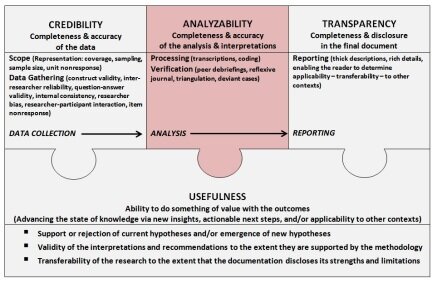Qualitative Data Analysis: Thick Meaning and Case Studies
Applied Qualitative Research Design: A Total Quality Framework Approach
As part of a three-month focus on data analysis you will find original writings, podcasts, and videos on all phases of the process for both qualitative and quantitative studies.
In this post we share an open-access blog posts from Margaret Roller, thoughtful methodologist and author of the award-winning text, Applied Qualitative Research Design: A Total Quality Framework Approach.
Analyzable Qualitative Research: The Total Quality Framework Analyzability Component
A March 2017 article in Research Design Review discussed the Credibility component of the Total Quality Framework (TQF). As stated in the March article, the TQF “offers qualitative researchers a way to think about the quality of their research designs across qualitative methods and irrespective of any particular paradigm or theoretical orientation” and revolves around the four phases of the qualitative research process – data collection, analysis, reporting, and doing something of value with the outcomes (i.e., usefulness). The Credibility piece of the TQF has to do with data collection. The main elements of Credibility are Scope and Data Gathering – i.e., how well the study is inclusive of the population of interest (Scope) and how well the data collected accurately represent the constructs the study set out to investigate (Data Gathering). Click this link to read the entire post.
Qualitative Analysis: ‘Thick Meaning’ by Preserving Each Lived Experience
My approach to qualitative data analysis has nothing to do with Post-it Notes, clipping excerpts from transcripts (digitally or with scissors), or otherwise breaking participants’ input (“data”) into bite-size pieces. My approach
is the opposite of that. My goal is to gain an enriched understanding of each participant’s lived experience associated with the research questions and objectives and, from there, develop an informed contextually nuanced interpretation across participants. By way of deriving “thick meaning” within and across participants, I hope to provide the sponsor of the research with consequential and actionable outcomes. Click this link to read the entire post.
Analyzability & a Qualitative Content Analysis Case Study
Kuperberg and Stone (2008) present a case study where content analysis was used as the primary research method. It is an example of how many of the Total Quality Framework (TQF) concepts can be applied — not only to the in-depth interview, focus group, observation, and case centered methods, discussed elsewhere in Research Design Review, but — to qualitative content analysis. The discussion below spotlights aspects of this study relevant to one of the four TQF components, Analyzability. Click this link to read the entire post.
Qualitative Analysis: A Reflexive Exercise for Category Development
The second component of the Total Quality Framework (TQF) is Analyzability. This component provides researchers with critical thinking considerations relevant to the completeness and accuracy of their analyses and interpretations of the data. Analyzability consists of two fundamental elements — processing and verification — the first of which involves coding followed by deriving categories and themes from the data.
From a TQF perspective, a useful exercise for category development — particularly when the study entails multiple researchers and a large amount of data — is by way of the reflexive template. Although similar in spirit to the writing function in computer-assisted qualitative data analysis software programs, the primary purpose of this reflexive template is to encourage researchers to actively reflect as they go about developing categories or buckets from the underlying constructs gained from the data. By way of the template, the analyst can document the relationship they perceive between the category and the construct as well as provide an example or further input to support their thinking. Click this link to read the entire post.




